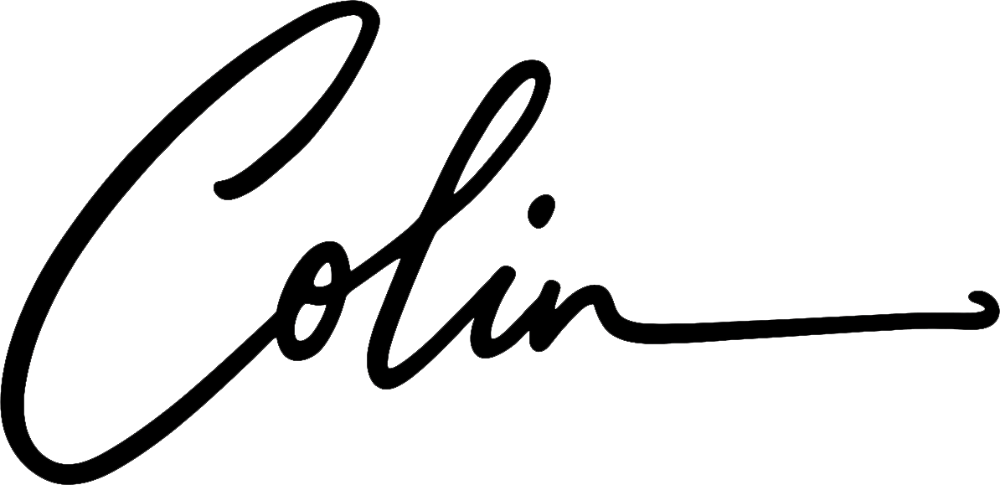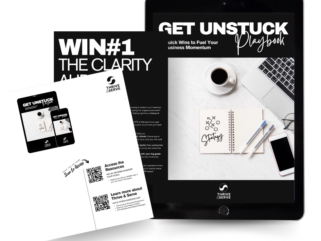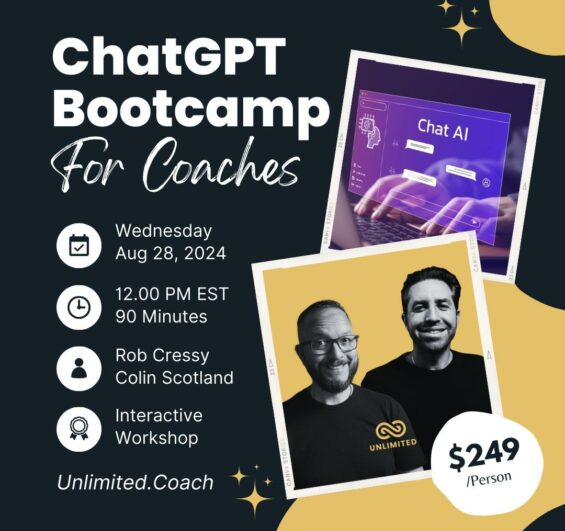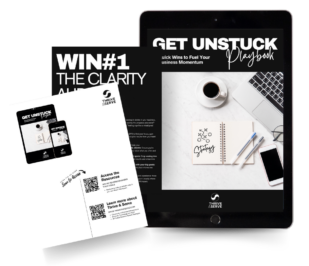The Cycle of Marketing Planning
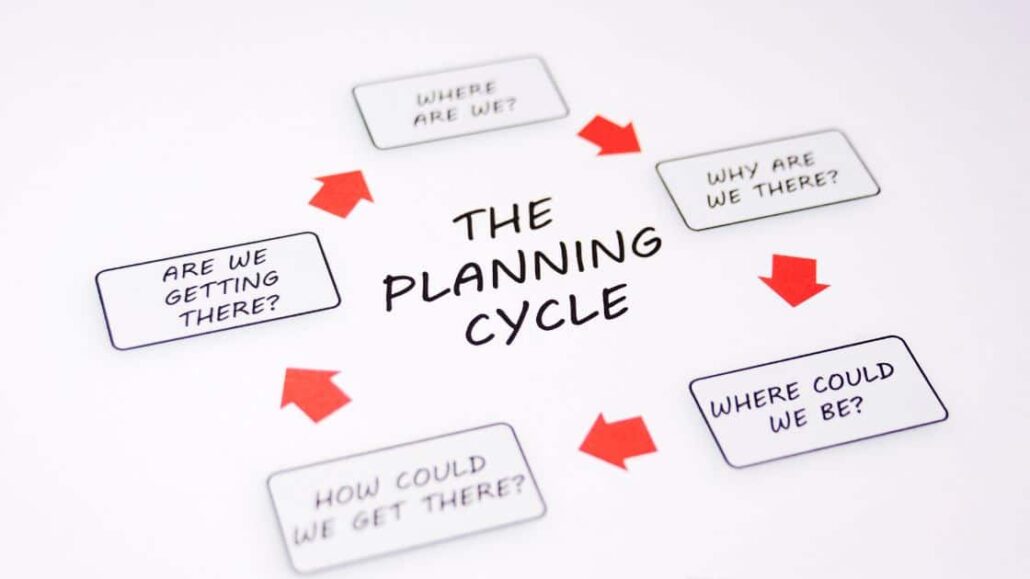
This post will give you a different perspective on the marketing planning process. A top-down look at the entire marketing plan, showing you how to plan for success using a rock-solid framework that will ensure your marketing efforts pay off. You'll discover… How to "think" like a marketer… and then… put your "thinking" into action! What questions to ask yourself… and when to ask them!
The marketing planning process hinges upon three simple questions: where are you right now? Where do you want to be? And then the bit in the middle, how on earth do you get there? This is an approach that is universal to many, many things.

Analyze Where You Are Now
Where are you right now in your business? Where are you right now in your personal life? Where are you right now in your career? Where are you right now in the hobbies and personal pursuits that you enjoy?
When you contrast that with where you want to be, what that does is that it opens up the doorway and avenues to possibility since we cannot make a marketing plan if we do not know where we are going. We cannot just jump in the car and start driving and expect to arrive at a destination if we do not know which way we are headed or which route to take, we would be driving yes, but aimlessly. Similarly, taking what Buddha called right action in your business happens naturally when you have clarity on your vision and your goals. When you have a clear destination you can plan your route and get on with the business of getting there.
Become Clear About What You Want
In fact, can we even get there by car in the first place? Do we need to take a plane or a train or a boat? How on earth can we expect to answer these questions if we are not clear on why and what we are setting out to do in the first place?
When we dive into each of these three questions; where are you now? Where do you want to be? And how do we get that?
It is the answer to these questions that form your marketing plan, that forms any plan that you put together for driving your business or your life forward.
Next, we are going to look at the where are we now question.
Where are you now?
The first question we ask in the marketing planning process is really an interesting one because what it does is that it causes us to pause, take a breath, and look around at the position that we are actually in, in space, in the universe, on the rock that is spinning around at 60,000 miles an hour hurtling through the galaxy. Where are you right now?
Where are You in Your Business?
We can place this into the context of our business. We can look at sales numbers, we can look at numbers of clients, numbers of products, and we can give context to the where are we now question by looking at our current situation.
In a marketing plan, typically, this will be what is termed a situational analysis and this is looking at our business, the environment in which the business exists, and addressing questions about the current state of affairs.
Where is your business right now in terms of sales? Where is your business right now, in terms of things such as profit, numbers of products sold, numbers of products available, size of the audience, size of your email list, social media marketing audience, and the number of website visits from organic traffic? You can start high level and then get very granular.
I think it is always helpful if you start with the big questions and work your way down to the detail.
The Environment - P.E.S.T. Analysis
When you scan across the environment, there is an acronym called P.E.S.T. PEST is a way of classifying things that happen in the environment, so that you are aware of things that could come up.
Let us be real, the world is so volatile, there are so many fast-moving changes, that it is virtually impossible to make predictions about what will happen. But if you have a handle on what is going on out in the world, then that context allows you to make better decisions at the moment.
It is not about predicting, it is about making the most informed decisions that you can. It is about having a broad understanding of the environment within which you do business. Using search engines, industry news, and articles you should aim to keep abreast of happenings in your field.

P stands for Political factors.
E stands for Economic, national, and local within the industry and the overall economy since these things affect consumer spending, disposable income, and attitudes towards spending.
S is for Social which is about the behavior of the people in and around and even outside of your industry in society. What are the trends, and what things are happening, that could impact you?
And then the final and arguably, most volatile, most disruptive of all, the T in PEST stands for Technological factors. We are living through such an amazing age right now where technological changes are going at such a pace that they are often hard to keep up with.
But the excitement of that on the flip side is that it provides so much opportunity and we will get to that shortly.
Therefore, step one in the where are we now question is looking at the past, a scan of the environment, political, economic, social, and technological. What things are happening in each of those areas? Scan around, look, read, research, Google, search on the internet, and find what is happening in those areas because they can have an impact on how your plan moves forward.
That's part one of the where are we now question, scanning the macro environment. Part two is to look at the micro environment, and what is happening inside the business in more detail.
Strengths Analysis - What Are You Good At?
When it comes to answering the where are we now question at a micro-level, we look at internal Strengths and Weaknesses, external Opportunities and Threats.
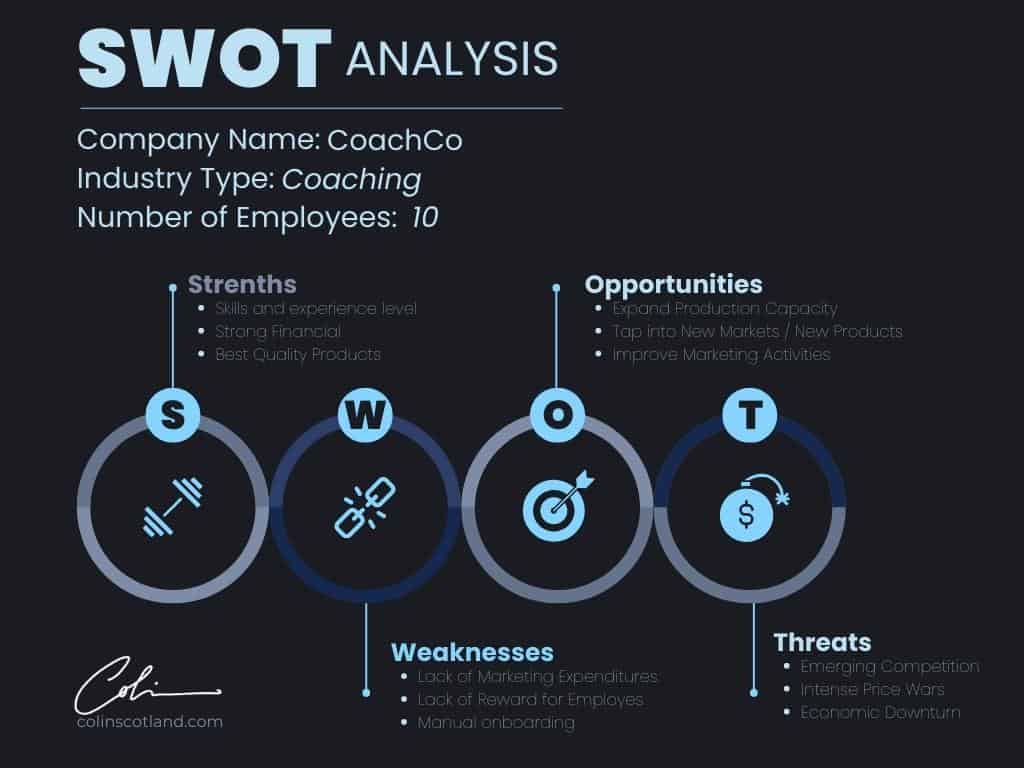
Scanning The Micro and Macro Environments
Think of it in two parts, we look internally, at you, your business, and your team and we look at your strengths, your core competencies, and your weaknesses.
Next, we look at the external environment of your competition in the market and we look at opportunities and threats in the market.
What I would like you to do is to write out strengths, weaknesses, opportunities, and threats as a square grid. I like to use an online whiteboard so you can add, move and change things around easily.

List all of the things that come to mind in each of those categories. What are we good at? What are our strengths, and what do we do well? Write those things down under the Strengths column.
What could we do better, and where might we improve? What are our weaknesses? Write those down under the Weaknesses column.
Meaningful Analysis is all about Perspective
Here is an interesting thing about this kind of analysis, things are interchangeable. Weakness can become a strength, strength can become a weakness, an opportunity can be a threat, and a threat can be an opportunity.
It is all about perspective, and so the goal of going through this process is to give you perspective because, with perspective, you can see opportunity. You can innovate and you can do things in the world that have never been done before because you see and are able to seize the opportunity.
So your first pass at the opportunities list will be, as you understand it right now, what opportunities are out there? Nobody is teaching how to do X with Y? Yes, there are loads of people doing this, but they are not doing it from the angle of Z.
What are those opportunities? Here is where you really will benefit from closing your eyes and triggering your imagination as to what might be possible for you.
Then we look at the threats column, what could hurt your business? those ideas. It may be big competitors, it may be the changes in technology, the Internet does not exist anymore, imagine, can you imagine? What are some of the threats that could happen to affect what it is that you do or what you are planning to do?
The sum total of your analysis is that you have a working knowledge of yourself, your business, your strengths, your weaknesses, and opportunities and threats in the external environment that have come from the analysis.
So collectively, the analysis gives you a really insightful look at where the potential for something so critical lies, and that is a concept called unique selling proposition, a USP, that is something that we are going to talk about next.
Your USP, Unique Selling Proposition
A Unique Selling Proposition is, as Michael Porter calls it,
a source of sustainable competitive advantage.
It is something that sets you apart, makes you different, and causes you to stand out from the crowd.
Finding a USP for Your Business
A USP is something that your clients cannot get anywhere else. There are an almost infinite number of ways to create unique selling propositions and unique experiences around how you conduct your business and deliver results.
Often in smaller businesses, solopreneurs, and small teams, there is a sense of David and Goliath, right? We cannot compete with the big guys with the big competitors. They are just too big, they have got too many resources.
Remember, from your analysis, that one thing that we may conceive as a threat, is being able to flip and become an opportunity. Because we are small we can be nimble and bring new solutions to the market so much faster. This is just one example of how factors can be interchangeable and fluid depending on how we look at them.
Using Analysis to Find Your USP
My challenge to you is to look at the analysis that you have done and consider what are the opposites here. Where can we flip an opportunity onto its head to make it a threat? Where can we flip a threat on its head to make it an opportunity? This is a great way to start seeing new strategies and new opportunities.
There is a wonderful saying by Marcus Aurelius:
The impediment to action advances action. The obstacle, therefore, is the way.
Challenge Your Thinking
One of the things I would have you consider in all of this, a key takeaway is to be able to challenge the way that you think about something. Challenge the way that you see threats challenge the way that you see opportunities, and challenge, most of all, the way that you see and view your capacity, limitations, and what is possible for you, because if you open up to possibility, then anything can happen.
Look at things in the analysis that you have written down and have been considering and mulling over. Then look at them from the opposite angle. Just in doing that, you will open up doorways, avenues, pathways, and potential that you never thought possible.
The Uniqueness is You
This is where you can find that USP, that uniqueness, and sometimes that uniqueness is simply you. If you are a coach and influencer an expert, that uniqueness is you because of all of the billions of people on the planet there is only one you. So whilst it is true that there is nothing new under the sun, your interpretation of those same things is entirely unique.
Where do You Want to be?
Once we have a handle on our situation, then it becomes a real "Imagineering" as Walt Disney called it. Imagineering is an act of allowing ourselves to place our future self, business, or life, into a dreamland, into an imaginary world of what could be.
Where could we be? What could we be? What could we realize? And really paint a picture in your mind.
I would love to be in this business that looks like this. I would like to have this number of clients, this number of new customers, this amount of revenue, this amount of profit, and this amount of time freedom. This is how I want to spend my working time.
What Does Success Look Like for You?
Take a moment to reflect on where you want to be. What does a successful outcome in all of this look like for you? Do not just limit the "where do you want to be" question to sales, profit, clients, and money.
What about you? As the business owner? What about your time? Your attention? Your energy?
What does an ideal day look like for you? Where do you wake up? What do you spend your day doing? What do you eat for breakfast? Who do you wake up next to? What can you smell? What can you taste? When you go and open the curtains, what do you see?
Create a Vivid Picture of Where You Want to be
You know, the human brain is a marvelous organism. The human brain does not know the difference between imagining and visioning something and experiencing it.
Physiologically, the same things happen, when we imagine, when we read a book, we experience physiologically, the same things as we would if we were actually to experience those things. It is quite magical, isn't it?
So the process of painting a picture of where you want to really will work wonders because it gives you a stake in the ground, a flag at the top of the mountain where you want to be. It gives you a vision, it gives you something to aim at, it gives you a destination, and that destination is what dictates what you need to do next.
So take a moment to close your eyes, take a deep breath in and consider where you want to be personally, professionally, emotionally, spiritually, and finally, financially in your business.
What does that end goal look like? When you have got a list of goals, these are what drive you forward.
Form Your Why
This forms your purpose and your reason for being, your raison d'etre. This, as Nietzsche, the German philosopher put it is the thing that keeps you going when the going gets tough.
He who has a why to live can bear almost any how.
How beautiful is that? What that means is, as you fall flat on your face trying to implement and get to your business goals, which you will, you get up and you keep on implementing. You keep on walking up that mountain because you want to get to the destination.
Your why is what drives you forward, your will, your desire, your intent, and your wish to realize this goal, emotional investment in the outcome is what keeps you moving forward.
When the flaming arrows come and they will come, you will keep striding forward. So, connect with that dream outcome. Connect with that goal, that vision. Make it vivid. Make it as vivid as you can and do not restrict it to just your business because you are so much more.
How do You Get There?
You have answered perhaps the most important question where do we want to be by creating that vision, that vivid picture of what life can and will look like for you? And yes, we can take this on a very business level. Yes, we can take this on numbers and profits and goals and clients and all of that. From a strictly marketing perspective, that is exactly what we do.
From a more holistic perspective, we look at ourselves personally, professionally, and our emotional, physical, and financial categories.
So the third question comes in, how do we get there?
We want to be on top of that mountain. What are the steps that we need to take? Now, often what happens at this point is people will say, "well, Colin, I don't know what steps to take, what route, I don't know where I should be focusing my energy and my time."
Where to Begin
There is a process to uncover what those steps are. And we do something that Stephen Covey talks about when he says,
Begin with the end in mind.
And the end is where do we want to be? Let us take a simple example. Let's say we want to be at $100,000 a month in revenue in our business. That is our goal. That is our flag at the top of the mountain.
What steps do we need to do working backward from that? What steps do we need to do in order to get there? Well, where are we right now?
Okay, we are currently on $20k a month, for example. How do we get to 100k a month? What steps do we need to take?
We have got 10 clients driving that revenue of $20k. We would need to get five times as many clients every single month to hit our goal. So what do we need to do to get 50 clients per month? Do we need more offers? Do we need more exposure? How can we get to the goal number in the easiest way?
Scaling Your Fulfilment
What does scalability look like? We may need to scale our fulfillment so that we can handle five times as many clients. We need to scale our lead generation efforts so that we actually can get five times as many clients.
Now, can you see how just by exploring that "how are we going to get there" question? We have uncovered two areas that we could focus on in our business, we can focus on fulfillment and process and we can focus on lead generation.
How can we get in front of audiences so that instead of hitting 10,000 people a week, we are hitting 50,000 people? How could we leverage the power of influencer marketing to get in front of other people's audiences who already have the ear of 100,000 people or 50,000 people, or a million people?
This kind of thinking triggers questions that allow you to uncover pathways or potential pathways.
Become Open-Minded and Curious
It is a case of discerning and intuiting which are the best pathways forward. To do that, you have got to be curious and you have got to be experimental. Become open to playing with possibilities in order for you to find, refine, and embrace a pathway that will work for you.
Stay open and map out what those steps need to look like to get you there. You can be very pragmatic in that. You can be very methodical in that, but be playful, curious, and experiment along the way. And practically, if you are struggling and you are going, "Hey, but I just don't know where to start."
Then take a blank piece of paper, close your eyes, and picture that end goal, that vision. What does that need to look like? How can that be a reality? Empty out all the things that come to your brain and brain-dump them on that piece of paper. Everything and anything that comes to mind.
You will be so surprised at how when you allow yourself the space, your brainpower, and your intuition will really help you to fill in those gaps.
Look around at other people that are doing that thing that you are looking to do, how are they doing it? What are they doing? Not so that you can copy but so that you can be informed and inspired. Collect an inspiration file as to what other people are doing.
You can draw on that as fuel for your own creativity. What are the steps that you need to take to get to where you want to be? Answering this question really does give us the basic elements that you need to put together the tactical part of your marketing plan, the things you will do in terms of marketing strategies, and tactics.
Start with Goals and Business Objectives
Now if you have spent time with each of the exercises as we have gone through, you will have a whole heap of things of ideas of possibilities. It is really about organizing them into something workable, something that can become a tangible and workable plan. That plan starts with setting some goals and objectives.
Our goal is the flag in the mountain that we spoke about when we imagined where we want to be. How do we break that down into some objectives?
From a business perspective, we could look at sales, profit, the number of clients, average order values, and lifetime customer values, and break these down into this is what it is now and this is where we want it to be. Then the steps or milestones to achieve the goal become our plan.
I would love for you to set those visions that you did, that you created into concrete goals, things that you want to achieve, and then work on breaking those goals down into objectives.
I study jujitsu. I have practiced Brazilian jujitsu since 2014. I am currently a brown belt. My goal is to become a black belt in Brazilian jujitsu in the next three years. At the moment, I'm a brown belt, and each belt has four stripes. After the fourth stripe, the fifth promotion is to the next color which is black. So, currently, I am four stripes away from my black belt. How do I get to that black belt in jujitsu? Well, I need to work on stripe number one, then stripe number two, etc. The black belt is the goal, the stripes are the objective.
S.M.A.R.T Objectives
For objectives to work it is best if they are SMART:
- Specific
- Measurable
- Actionable
- Realistic
- Timebound
A smart objective for my BJJ studies would be to achieve stripe number one on my brown belt within the next six months.
- Specific - stripe one
- Measurable - have I achieved the stripe? Yes or no?
- Actionable - if I turn up to class and train consistently, yes.
- Realistic - Stripes at this level usually take between six and twelve months to achieve
- Timebound - within six months, so yes.
Can you see how the goal of achieving the black belt has been broken down into objectives?
Some measurable objectives are tied to the goal. The goal is the top of the mountain. The objectives are the milestones, the ways that we know that we are on track to reaching our destination.
Break down your goals into SMART objectives with milestones. It is those milestones that drive activity on a weekly, daily, and hourly basis your actions in your business, and your marketing.
Action: Set goals and objectives for your business.
Strategies and Tactics
Now we get down into the nitty-gritty. Once you have got the goals and objectives set out. It is really about looking at two things, marketing strategies, and marketing tactics. They are both different, but they are complementary, they fit together.
Our strategy may be to increase our market share in a specific area of focus, a specific market, that is a strategy. The tactics might be to do more advertising, make more content, produce more stuff on social media, and be more active in online communities. That is tactics, doing the nuts and bolts.
Strategy is the high-level approach, then what we are going to do, tactics are the how we are going to do this, the tactical battle plan.
What is Your Business Battle Plan?
Let us get into strategy and tactics to give you a flavor and an understanding so that you can begin to understand which strategies and tactics are going to be the best for you.
What strategies and tactics are going to help you to achieve your goal?
So now, everything is filtered by your North Star, your goal, your vision, realizing that thing that's important to you, that's what drives strategy and tactics, strategy and tactics alone don't work.
You can bang your head against the wall, pushing content out and social all day long and it won't work. If it's what I call content with intent, and it's there for a purpose and a reason to intentionally help you achieve your objectives and get you to your goal, that's when it works well to generate leads and clients.
There are broadly speaking, three types of marketing strategy.
Focus Strategy
Focus, is where we bring something new, something different. We zag when everybody else is zigging, and we find the blue ocean. We look at finding ways of doing things a little differently from others.
We look to innovate, we look to be different, and we look to narrow our focus on a specific niche. That is a focus strategy.
Cost Leadership
The second is cost leadership. Cost leadership is not my favorite strategy. It is about being the cost leader, being cheap, and focusing on price.
This happens more in bigger businesses, but they will typically use cost leadership strategies to buy market share and make it work because they own the distribution channels. They go in cheap, they capture the market, and they raise the price. That is a cost leadership strategy.
It is a short-term strategy with a longer-term aim in mind. It is not for the faint-hearted, nor is it for brands that don't have significant resources and/or strengths in the distribution channels. If you're small, you should be focusing on a focus or differentiation strategy.
Differentiation
The third, and arguably most interesting strategy is one of differentiation. How are we different? So the focus strategy is about narrowing the field, narrowing the niche. Differentiation is looking at being completely different. It is like focus but on another level.
Differentiation becomes possible by embracing YOU because you are unique, you are the only one of your kind on the planet right now. Embracing your personality, and leveraging your personal brand can become a really interesting angle and strategy. That strategy is called differentiation. Personal branding as a coach, influencer or thought leader mostly falls into the differentiation category.
Those three kinds of main approaches to strategy come from Michael Porter. They are the main options when it comes to deciding the best strategies to adopt.
Tactics, Tactics, Tactics
When it comes to tactics, tactics are legion. There are so many marketing tactics, including social media, email marketing, content marketing, advertising, and PR, the list is almost endless. I'm not going to go through a list of tactics here, because let's face it, you can Google tactics until the cows come home and have an endless list.
More on marketing tactics later. What I would encourage you to focus on is what tactics are going to get you to your goal.
Clients
Clients are the lifeblood of every business.
Marketing is defined by the Chartered Institute of marketing in the UK as
the identification and satisfaction of customer requirements profitably.
The Chartered Institute of Marketing
The needs that you satisfy are those of clients or your target audiences. There is an interaction and exchange in a transaction of value, you satisfy needs, both parties profit, you profit by exchanging money, and your business profits because you amass money that sits as profits in your accounts at the end. That is the essence of all marketing.
Marketing and Satisfying the Needs of Clients
We have spoken so far about you, the environment, what you are good at, or you are not so good at, where the opportunities lie, where the threats lie, where you want to be, what your goals are, and what your objectives are.
We have begun the process of considering strategies and tactics, the difference between the two, and how we may begin to consider the different ways to achieve our objectives with those strategies and tactics.
Now we come to the biggest driver, beyond our why, and our vision in all of this, your target audience.
The Most Successful Marketing Plan Puts Clients First
Who are the people that benefit from what you do? Who are the people that value what you do? Who are the people that can pay for your products or services? Who is the target market?
The answers to these questions, really start you thinking about who your ideal client is because the very best marketing plans put the client in the center of everything. Create a Client Profile to begin the process of understanding your ideal target audience. This is a process, in marketing planning called market segmentation, you are looking for traits that are true for an individual and also for a shared group, or segment of people that you can sell to.
Prison to Paradise
The very best marketing plans will consider the client in two phases. I call it prison to paradise.

The Problem, or Prison State
Consider your ideal client before they have utilized your product or service, they are in the problem or prison state, where something is not right, and they have a problem that they are looking to resolve.
What is that problem that you solve? What does their world look, sound, and feel like in the prison state? What do they see? What do they feel? What do they say? What do they think? What are people saying to them? What are they hearing?
The prison state is very important because it allows us to understand where our clients are at. Then we contrast that with the paradise state.
The Solution, or Paradise State
What are your clients' lives like after they have utilized your service, your product?
This is the paradise state. What does paradise look, sound, and feel like for them? Typically, it is the antithesis of the prison state. So if I was anxious, I am now calm and at peace. Fear is replaced with confidence, joy, etc.
A really useful thing to do here is to grab a piece of paper and on the left side, write the heading prison. On the far right of the page, write down paradise, leave a gap in the middle because we are going to come back to that.
Now down the left-hand side, write down what prison looks like, what prison sounds like, and what prison feels like.
Then on the right-hand side, write down what the opposite paradise state looks, sounds, and feels like?"
If you have an existing business, you can talk to existing and past clients, you can ask them what life was like before they worked with you. And contrast that with what life was like after. You can have them express this through surveys, questionnaires, and interviews.
You can also research using Facebook groups and different places where people hang out on Quora or Reddit. You can read book reviews to see how people respond and react to content in your field and you can get a flavor and a feel for who your clients are, how they think, how they feel, what they see the kinds of thoughts and things that are running through their mind to paint a picture of the prison state.
Then contrast it with the paradise state after you have delivered your magic. The prison to paradise exercise gets you to think about the client but it also gets you to think about your products and services from the client's perspective, in terms of how you help them to solve problems.
Your Transformation Process
How do You Solve Problems?
Then we get to the really important bit, the middle bit. The middle bit is the process of how you solve those problems. This is getting into the nitty-gritty of what you do, your offers, and your service. Your process can also be an interesting source of USP. If you recall the strategy of differentiation, the way that you deliver your product, and your unique process, can be a source of uniqueness that sets you apart from your competition.
I want you to picture your ideal client on one side of a riverbank and we have got a fast-flowing river. It is too big to jump and they are on one side in the prison state. You are on the opposite side, the paradise side. The client wants to get across from one side to the other, they have got a problem that you can help them with.
What are you going to do? How are you going to get them from one side to the other?

If we take the river analogy, we would put big rocks into the river to make stepping stones that form a bridge across the river so the client can walk from one side to the other, to the paradise state. When you are presented with a client, in the problem state, in the prison state, what does your process look like?
I do not want you to think about the nitty-gritty here, I want you to focus entirely on the big rocks. What's important? What do we need to do with that client to get them to success, to get them to their desired outcome?
Just like you have considered your dream outcome and where you want to be, you need to understand this same thing for your clients. Where are they before working with you and where do they want to be after? In understanding this, you can provide content and services that fulfill their needs profitably, remember the definition?
Let me share my coaching process and marketing program with you as an example:
- The first big rock is to analyze the current state of being, the where am I now question. Usually, it's more clients and sales and more free time to do what they love to do.
- The second rock is to envision where the client wants to be and in what areas of their life and business. We create a vision that makes them giddy with excitement at the thought of making it a reality.
- The third rock is the how are we going to get there question. We create lead generation strategies and a blueprint for a marketing engine that will attract more potential customers and generate clients.
- The final rock of implementation takes them from one side of the river to the other, to the paradise state.
That is my coaching process. What is your process? What are the big rocks for you with your clients? Write them down.
How you solve the client's problem is the essence of how you deliver your wonder to the world, your unique process.
Your Products, Offers, and the Value Ladder
When you look in more detail at how you deliver your transformation to clients, and your process, there is a useful way to view the level and mode of transformation. It is to view from the perspective of value and price.
Using a simple map called a Value Ladder to plan what offers make up your product range.

Content Marketing and Traffic Strategy
Content is the driving force of your marketing efforts. There are three main different strategies you can utilize content to drive traffic in your marketing campaigns. Those three ways are owned, earned, and paid. Let's explore each of them.
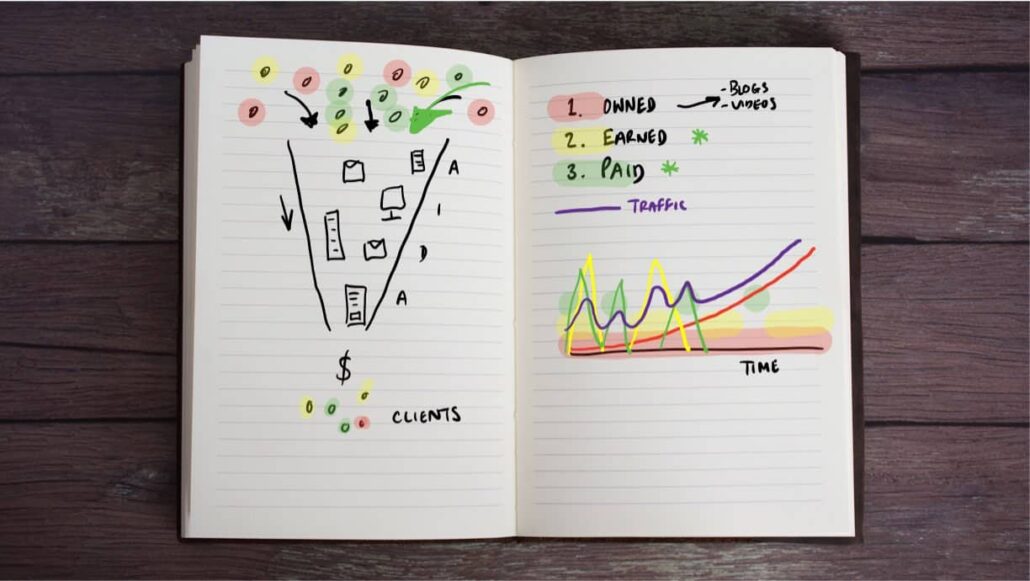
Traffic from Owned Media
Owned content is content that you own. It may be video content, audio, blog posts, training, courses, PDFs, books, or assets that you own that are proprietary to you. Pursuing an owned media traffic strategy is what I call the "long game." It takes time to climb the rankings in search engines.
If you focus on creating content that solves people's problems, then people are encouraged to move their way from prison to paradise utilizing your content and creating a positioning of you as the ideal solution to their problem. Content marketing is really about creating content with intent because it allows and encourages and facilitates the journey from prison to paradise. It helps your clients and meets them where they are at, in the prison state.
It helps them make a change, that is the kind of content that you create. This content is yours, it's proprietary. You go through a process of creating blog posts, a podcast, a YouTube channel, all of the things that are yours. Owned content can yield huge rewards. But it does take time to build. That is why it is classed as a long game. But content, organic growth, and appearing in search results on YouTube and Google take time.
Key Takeaway - You have to play the long game with your content marketing strategy.
Traffic from Earned Media
Earned traffic comes from leveraging the power of other people's audiences.
Imagine you are an influencer and you create content, you create a YouTube channel, you do a podcast, you write a blog, and you push content out on social media, all helping people with the problem that you help them.
Then you are invited to speak at an event in front of 100,000 people, you are earning exposure to that event's audience. The content that you create, your intellectual property, earns you the right to go and speak to these other audiences and benefit from all the referral traffic that comes as a result.
Owned content leads to earned traffic opportunities.
You are leveraging the power of other people's audiences. It may be that you speak at events, it may be that you do guest podcast appearances, where you talk about your area of expertise, the thing that you are great at. You are looking for ways that you can capitalize on and leverage other people's audiences.
Traffic from Paid Media
The third form of traffic is paid media. This is what most people think when they consider what marketing is, advertising, Pay Per Click ads on Google, YouTube, Facebook, etc. Paid media is essentially where you pay for exposure and traffic.
Your Content and Traffic Strategy
When you consider your content creation and traffic strategy, consider it in each of these three categories. Organic traffic from content that you own, should form the biggest percentage of what you do and can catapult you to whole new heights.
With paid media you can use specific campaigns as a tap or faucet, you can turn it on, you turn it off and it drives traffic as in when you need it.
The main area of focus should be owned content, blog, video, audio, social, organic, SEO, etc. as this is what positions you uniquely in the market and assists potential customers along the journey to becoming clients.
Now the key takeaway question for you is which of these tactics and channels are going to yield you the best results in getting to where you want to be? Because remember, everything is held up to the yardstick of where you want to be and what is going to help get you there. And, in answering that question, what will get me there? The correct places to play and marketing initiatives to pursue will reveal themselves.
Final Thoughts
So where do you want to be? What goals and marketing objectives have you set for yourself? And which of these content strategies and digital channels will get your business to those objectives in the best way? Get to work implementing your business strategy, and then review, rinse and repeat. Check out this blog post too - The Only Marketing Plan You'll Ever Need a guide to successful marketing strategies content creators and coaches.

